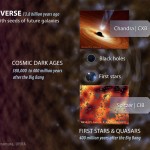Chandra, Spitzer study suggests black holes abundant among the earliest stars
The cosmic microwave background, shown at left in this illustration, is a flash of light that occurred when the young universe cooled enough for electrons and protons to form the first atoms. It contains slight temperature fluctuations that correspond to regions of slightly different densities, representing the seeds of all cosmic structure we see around us today. The universe then went dark for hundreds of millions of years until the first stars shone and the first black holes began accreting gas. A portion of the infrared and X-ray signals from these sources is preserved in the cosmic infrared background, or CIB, and its X-ray equivalent, the CXB. At least 20 percent of the structure in these backgrounds changes in concert, indicating that black hole activity was hundreds of times more intense in the early universe than it is today.
By comparing infrared and X-ray background signals across the same stretch of sky, an international team of astronomers has discovered evidence of a significant number of black holes that accompanied the first stars in the universe.
Using data from NASA’s Chandra X-ray Observatory and NASA’s Spitzer Space Telescope, which observes in the infrared, researchers have concluded one of every five sources contributing to the infrared signal is a black hole.
Credit: Karen Teramura, UHIfA
